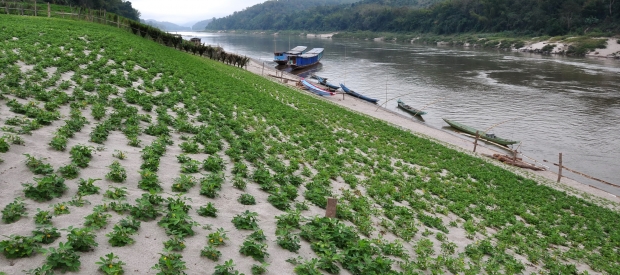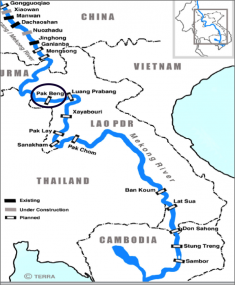Pak Beng Dam
The Pak Beng Dam is the northern most of eleven dams proposed for construction on the lower Mekong River mainstream. Located seven kilometers upstream of Pak Beng town, in Oudomxay Province, Northern Laos. The 912 MW project is expected to generate 4,700 GWh of electricity per year, of which 90% will be sold to Thailand and the remaining 10% to Laos’ state-owned utility, Electricite du Laos.
This exceptionally beautiful section of the Mekong River is a lush, mountainous area which locals rely on for riverbank farming, fishing and raising livestock. Rapids, pools, and complex riverine ecosystems make it an important habitat for fish and aquatic life. It is expected that 25 villages in Laos and two villages in Thailand will be directly affected by construction of the Pak Beng Dam, with an estimated 6,700 people re-settled.
The Pak Beng Dam would be located on a popular tourist route, just 100 kilometers from Luang Prabang, and a day’s slow boat from Chiang Khong in Thailand.
In 2007 China Datang Overseas Investment (Datang) signed a Memorandum of Understanding with the Government of Laos to develop the Pak Beng Dam. Following this agreement, in March 2014, Datang received environmental permits from the Lao Government for the hydropower project, announcing that it would undergo the MRC’s Procedures for Notification, Prior Consultation and Agreement (PNPCA) process, as required by the 1995 Mekong Agreement.
A report published late 2015, however, indicates that a Thai energy giant, Electricity Generating Holding Public Company Limited (RATCH), will also be involved in a joint venture with its Chinese counterpart, and possibly be an importer for electricity (798 MW) to Thailand.
A report obtained by International River in 2015, revealed construction activities underway on access roads and a bridge across the Mekong River from Pak Beng to Mung Gheurn in Xayaburi province.
Prior Consultation for the Pak Beng Dam officially began on December 20, 2016.
Communities in Thailand have already experienced transboundary impacts from dams on the Mekong River upstream in China, including sudden changes in water level, flooding of riverbank gardens, drought and loss of traditional fish catch. The lower Mekong dams will drastically compound these impacts, turning 55 percent of the lower stretch of the river into a series of reservoirs, blocking critical fish migration and the flow of nutrient rich sediment necessary to sustain regional agriculture and food security.
The rapid pace of dam development on the Lower Mekong mainstream - including the construction of the Xayaburi and Don Sahong Dams - has ignored calls from Mekong Governments, donors, scientists and concerned communities, for further studies, transboundary impact assessments and participatory regional decision-making.
There is an urgent need for regional governments to press the pause button on futher dams on the Mekong mainstream, to take stock of projects already under construction, to conduct further studies on the transboundary and cumulative impacts of these projects and to re-consider the dangerous approach being taken towards dam development on the lower Mekong mainstream.
- Read our Factsheet on the Lower Mekong Dams (in English, Khmer, Lao, Thai, and Vietnamese)
- Read our Factsheet on the MRC's Strategic Environmental Assessment on Mekong Mainstream Dams (in English, Thai, Vietnamese, and Japanese)
- Mekong River Commission website on the Pak Beng Dam Prior Consultation process




